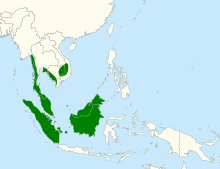| Black-and-red broadbill | |
|---|---|

| |
| Scientific classification | |
| Domain: | Eukaryota |
| Kingdom: | Animalia |
| Phylum: | Chordata |
| Class: | Aves |
| Order: | Passeriformes |
| Family: | Eurylaimidae |
| Genus: | Cymbirhynchus Vigors, 1830 |
| Species: | C. macrorhynchos
|
| Binomial name | |
| Cymbirhynchus macrorhynchos (Gmelin, 1788)
| |

| |
| Black-and-red broadbill distribution | |
| Synonyms | |
The black-and-red broadbill (Cymbirhynchus macrorhynchos) is a species of bird in the typical broadbill family, Eurylaimidae. It is the only species in the genus Cymbirhynchus. A large, distinctive bird, it has maroon underparts, black upperparts, a maroon neck-band, and white bars on the wings. It also has a large, two-colored, blue-and-yellow bill. The species shows slight sexual dimorphism, with females being smaller than males. No other bird in its range resembles it, though the black-and-yellow broadbill has a similar call.
The species is found in Brunei, Cambodia, Indonesia, Laos, Malaysia, Myanmar, Singapore, Thailand, and Vietnam. Inhabiting lowland riparian forest throughout its range, it can also adapt quite well to disturbed habitat, such as secondary forest growth and degraded habitat near rivers. The black-and-red broadbill is mainly insectivorous, supplementing its diet with aquatic creatures such as mollusks, snails, fish, and crustaceans. It also takes leaves and seeds incidentally.
Breeding takes place during the dry season throughout its range, with the nest being a large, conspicuous structure that usually hangs over water. Nests are built by both sexes, out of creepers, fungal hyphae, moss, and other plant matter. Eggs are laid in clutches of two or three, occasionally with a fourth runt egg, and incubated by both parents. The black-and-red broadbill is evaluated as a least-concern species by the International Union for Conservation of Nature due to its large range and the lack of a severe decrease in its global population. However, the species has experienced declines in several parts of its range, and may face threats due to deforestation, trapping for the songbird trade, and hunting.
- ^ BirdLife International. (2016). "Cymbirhynchus macrorhynchos". IUCN Red List of Threatened Species. 2016: e.T103656920A95026449. doi:10.2305/IUCN.UK.2016-3.RLTS.T103656920A95026449.en. Retrieved 23 August 2021.
